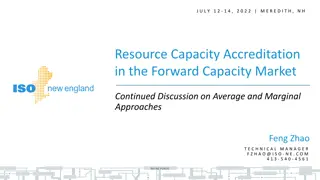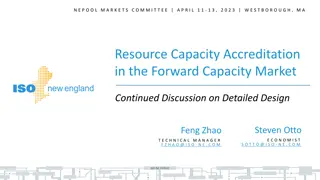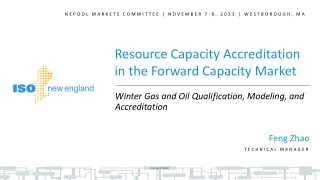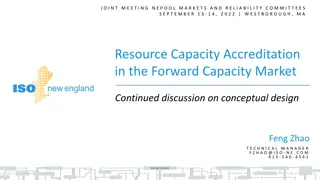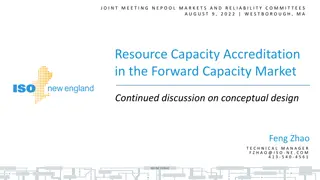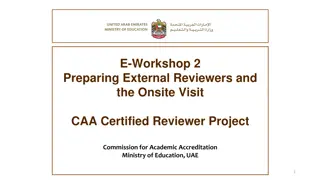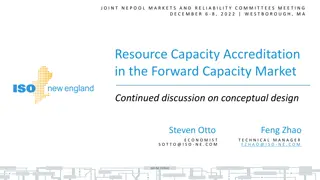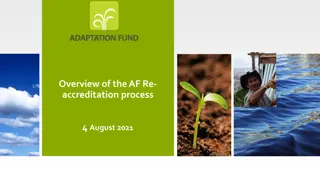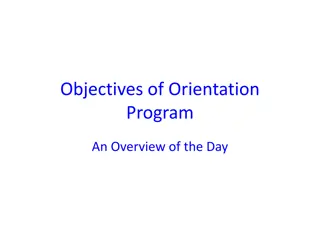Resource Capacity Accreditation in the Forward Capacity Market Discussion
The presentation discusses improvements in the Resource Capacity Accreditation project of ISO-NE's Forward Capacity Market to support a reliable, clean-energy transition. It includes details on seasonal components, reconfiguration auctions, trading obligations, and stakeholder schedules. Examples provided are for illustration purposes. Opportunities for enhancing capacity accreditation and resource adequacy assessments are highlighted.
Download Presentation

Please find below an Image/Link to download the presentation.
The content on the website is provided AS IS for your information and personal use only. It may not be sold, licensed, or shared on other websites without obtaining consent from the author. Download presentation by click this link. If you encounter any issues during the download, it is possible that the publisher has removed the file from their server.
E N D
Presentation Transcript
N E P O O L M A R K E T S C O M M I T T E E | M A R C H 7 - 9 , 2 0 2 3 | W E S T B O R O U G H , M A Resource Capacity Accreditation in the Forward Capacity Market Continued Discussion on Detailed Design Steven Otto Feng Zhao E C O N O M I S T T E C H N I C A L M A N A G E R F Z H A O @ I S O - N E . C O M S O T T O @ I S O - N E . C O M ISO-NE PUBLIC
WMPP ID: 157 Resource Capacity Accreditation in the Forward Capacity Market Proposed Effective Date: FCA 19 The Resource Capacity Accreditation (RCA) project proposes improvements to ISO-NE s accreditation processes in the Forward Capacity Market (FCM) to further support a reliable, clean-energy transition by implementing methodologies that will more appropriately accredit resource contributions to resource adequacy as the resource mix transforms The ISO has made a commitment to file proposed improvements to be implemented in time for FCA 19 This presentation will discuss seasonal components of CSO, annual reconfiguration auctions, monthly trading and seasonal PFP obligations Small numerical examples in this presentation are for illustration purposes only and do not reflect or imply actual market impact of RCA ISO-NE PUBLIC 2
WMPP ID: 157 Resource Capacity Accreditation in the Forward Capacity Market Proposed Effective Date: FCA 19 Outline of today s discussion: Review of MRI design (slides 5-11) Seasonal Components of CSO (slides 13-19) Annual Reconfiguration Auctions and Monthly Trading (slides 21-25) Seasonal PFP Obligations (slides 27-47) Stakeholder Schedule (slides 49-53) Appendices A: Annual and Seasonal PFP Obligations for Resource W (slide 55-63) B: Derivation of Resource S s Expected Performance and the Total Seasonal CSO Components (slides 65-69) C: Calculating expected balancing ratios (slide 71) ISO-NE PUBLIC 3
REVIEW OF MRI DESIGN ISO-NE PUBLIC ISO-NE PUBLIC 4
Presented August MC /RC Meeting RCA Improvements Opportunity #1: Current capacity accreditation framework can be improved to reflect different resource contributions toward resource adequacy. These adjustments will better yield accredited capacity that is substitutable between resources, which is beneficial as unique resource types enter the market RCA will implement a MRI framework that improves resource substitutability Opportunity #2: Current resource adequacy assessment process can be improved to better reflect resources expected performance and reliability contributions as the resource mix changes RCA will improve resource adequacy assessment modelsfor more accurate calculation of resource accreditation values ISO-NE PUBLIC 5
Introduced January MC Meeting MRI Marginal Reliability Impact (MRI), in hours/year, reflects a resource s expected availability when its Qualified Capacity (QC) is needed for system reliability in RAA simulations (Annual) MRI is calculated as ( EUE/ QC), with EUE being Expected Unserved Energy and QC being the FCA QC Summer MRI is calculated as ( EUE/ SummerQC), and Winter MRI is calculated as ( EUE/ WinterQC) ISO-NE PUBLIC 6
Interpretation of MRI MRI represents the expected number of hours that a resource is available at QC, when capacity is needed for adequacy (QC MRI) represents a resource s reliability contribution or its expected energy production (MWh/year) during simulated reliability events Reliability contributions are additive and substitutable: Number of Summer available hours at SummerQC Number of Winter available hours at WinterQC Number of Annual available hours at FCAQC QC x MRI = SummerQC x SummerMRI + WinterQC x WinterMRI Annual contribution Summer contribution Winter contribution ISO-NE PUBLIC 7
Introduced July MC/RC Meeting QMRIC A resource s new accredited capacity, Qualified MRI Capacity (QMRIC), reflects its annual reliability contribution normalized by perfect capacity MRI, i.e., ??? ????? = ?? ?????????? relative MRI (rMRI) Replacing MRI by seasonal MRIs, QMRIC can be represented as ???????? ????????? + ???????? ????????? ?????????? ?????????? Summer component Winter component ISO-NE PUBLIC 8
Introduced July MC/RC Meeting CSO and ECSO The market clearing yields two sets of obligation quantities: The new Capacity Supply Obligation (CSO) or cleared QMRIC, and Effective CSO (ECSO), the physical quantity associated with the CSO ECSO is seasonal QC ECSO Physical quantities QC ECSO 1/rMRI rMRI FCM Clearing Market quantities CSO QMRIC QMRIC CSO Seasonal components of CSO will be introduced ISO-NE PUBLIC 9
Introduced July MC/RC Meeting RAA Process Resource Adequacy Assessment (RAA) is a probabilistic simulation process for calculating ICR, demand curves, resource MRIs and QMRICs RAA load and resource models are enhanced MRIs, QMRICs Enhanced load and resource modeling QCs RAA ICR, demand curves Other parameters ISO-NE PUBLIC 10
Presented August MC /RC Meeting MRI-based Capacity Market The ISO has already applied the MRI concept to its capacity demand curves MRI-based Zonal Demand Curves By applying the same MRI concept and consistent resource mix assumptions to both supply and demand sides of FCM, the supply and demand will properly align MRI-based Demand Curve MRI-based Resource QC accreditation Accreditation ISO-NE PUBLIC 11
SEASONAL COMPONENTS OF CSO ISO-NE PUBLIC ISO-NE PUBLIC 12
Seasonal Components of QMRIC Resource s QMRIC represents its annual reliability contribution (normalized by MRIperfect), as the sum of its seasonal components or contributions, i.e., ????? = ???????????+ ??????????? The above seasonal (summer or winter) components of QMRIC are: ???????????= ???????? ?????????/?????????? ???????????= ???????? ?????????/?????????? ISO-NE PUBLIC 13
Seasonal Components of CSO, cont. CSO is the clearedportion (CSO/QMRIC) of QMRIC Similar to QMRIC, a resource s annual CSO can also be represented by the sum of its summer and winter components: ??? = ?????????+ ????????? The summer or winter component of CSO represents the same cleared portion of the corresponding seasonal QMRIC component: ?????????= ??????????? ???/????? ?????????= ??????????? ???/????? ISO-NE PUBLIC 14
Seasonal ECSOs With seasonal components of CSO, seasonal ECSOs can be directly linked to those seasonal components rather than the annual CSO: ?????????? = ???????? ???????????????????? ?????????? = ???????? ???????????????????? The above seasonal ECSO represents the same portion of corresponding seasonal QC as the cleared portion ISO-NE PUBLIC 15
Example: Seasonal Components of QMRIC and CSO Suppose that RAA simulations yield 10 reliability hours: 8 hours in summer and 2 hours in winter The perfect capacity with QC = SummerQC = WinterQC is available at its QC for all reliability hours, i.e., MRIperfect = 10 hrs/year Suppose that a resource with SummerQC = 100 MW is available for 7 hours during summer reliability events (i.e., SummerMRI= 7 hrs/year) The resource s summer reliability contribution is 700 MWh/year (= 100MW x 7 hrs/year), and the summer component (normalized by MRIperfect) is QMRICS = 70 MW Suppose that the same resource has WinterQC = 120 MW but is available only for 1 hour during winter reliability events (i.e., WinterMRI = 1 hrs/year) The resource s winter reliability contribution is 120 MWh/year (= 120MW x 1 hrs/year), and the winter component (normalized by MRIperfect) is QMRICW = 12 MW The resource s annual accreditation is: QMRIC = 82MW (=70MW+12MW) ISO-NE PUBLIC 16
Example: Seasonal Components of QMRIC and CSO, cont. The resource with QMRIC = 82 MW enters FCA and clears half of it, i.e., CSO = 41 MW (= 50% QMRIC) The summer component of CSO is half of the summer component of QMRIC, i.e., CSOS = 35 MW (= 50% QMRICS = 0.5 70MW) The winter component of CSO is half of the winter component of QMRIC, i.e., CSOW = 6 MW (= 50% QMRICW = 0.5 12MW) ????? (82??) = ???????????70?? + ???????????(12??) 50% 50% 50% ???(41??) = ?????????(35??) + ?????????(6??) ISO-NE PUBLIC 17
Example: Seasonal Components of QMRIC and CSO, cont. The resource s seasonal ECSOs will correspond to its seasonal components of CSO The summer component of CSO is half of the summer component of QMRIC Summer ECSO = 50 MW (= 50% SummerQC= 0.5 100MW) The winter component of CSO is half of the winter component of QMRIC Winter ECSO = 60 MW (= 50% WinterQC= 0.5 120MW) ISO-NE PUBLIC 18
Key Takeaways of Seasonal Components of CSO QMRIC represents a resource s annual reliability contribution and will be separated into summer and winter contributions CSO is the cleared portion of QMRIC, and will also be separated into summer and winter components Under the annual market framework, seasonal components will be defined to reflect a resource s seasonal capabilities and contributions ISO-NE PUBLIC 19
ANNUAL RECONFIGURATION AUCTIONS AND MONTHLY TRADING ISO-NE PUBLIC ISO-NE PUBLIC 20
Annual Reconfiguration Auction (ARA) Similar to the current ARA design, resources under RCA will be able to shed their annual CSOs or sell un-cleared QMRICs in ARAs Quantities cleared in ARAs will net with resources previous CSO positions A resource s summer and winter QCs are updated each year, resulting in update of its QMRIC: QMRIC = SummerQC x (SummerMRI/MRIperfect) + WinterQC x (WinterMRI/MRIperfect) We propose to fix resources seasonal MRIs for each auction associated with the same Capacity Commitment Period (FCA, ARAs, MRAs and bilaterals) to their values calculated for the FCA This allows the same capacity product and same perfect MRI reference acrossall auctions for the same Capacity Commitment Period QMRIC of a resource will be updated as a linear function of its QCs ISO-NE PUBLIC 21
Example: ARA Consider the previous example summarized in the below table Suppose that the resource s summer and winter QCs both increase by 5 MW, resulting in 4 MW of QMRIC increase (also shown in table) Given that the resource has 41 MW un-cleared QMRIC from FCA, the total QMRIC that the resource can sell in ARA is 45 MW (= 41MW + 4MW) Suppose the 45 MW clears in ARA CSO = 41 MW + 45 MW = 86 MW Resource Summer QC (MW) Summer MRI (hrs/yr) QMRICS (MW) Winter QC (MW) Winter MRI (hrs/yr) QMRICW (MW) FCA QC (MW) QMRIC (MW) CSO (MW) FCA 100 7.0 70 120 1.0 12 100 82 41 ARA 105 7.0 73.5 125 1.0 12.5 105 86 86 MRIperfect = 10 hrs/year (8 hours in summer and 2 hours in winter) ISO-NE PUBLIC 22
Monthly Trading Similar to the current design, a resource can shed or take on obligations through monthly reconfiguration auctions or bilateral trades The monthly trading of a resource s capacity must be based on its physical capability, e.g., A resource can only sell non-obligated QMRIC supported by its non- obligated QC of the month A resource cannot shed the CSO supported by its physical capability in a different season from the month We propose to trade monthly based on seasonal components of CSO ISO-NE PUBLIC 23
Example: Monthly Trading Consider the previous example with the resource having a CSO of 86 MW (73.5MW summer component and 12.5 winter component) entering the monthly tradeing see the below summary table Suppose that the resource wants to shed its CSO in December MRA, then the resource can shed no more than 12.5 MW, resulting a CSO of 73.5 for the month Resource Summer QC (MW) Summer MRI (hrs/yr) QMRICS (MW) Winter QC (MW) Winter MRI (hrs/yr) QMRICW (MW) FCA QC (MW) QMRIC (MW) CSO (MW) ARA 105 7.0 73.5 125 1.0 12.5 105 86 86 MRA 105 7.0 73.5 125 1.0 12.5 105 86 73.5 MRIperfect = 10 hrs/year (8 hours in summer and 2 hours in winter) ISO-NE PUBLIC 24
Key Takeaways on ARAs and Monthly Trading Resource QMRIC will be updated in ARAs due to updated QCs while the MRIs are fixed for all auctions associated with the same capacity commitment period Monthly trading based on seasonal components of CSO is consistent with a resource s seasonal physical capabilities ISO-NE PUBLIC 25
SEASONAL PAY-FOR-PERFORMANCE (PFP) OBLIGATIONS ISO-NE PUBLIC ISO-NE PUBLIC 26
Section Overview: In Response to Stakeholder Feedback, ISO is Considering a Seasonal PFP Design The October MC/RC materials noted that, with the RCA reforms, each resource that takes on a CSO would be responsible for a constant share of the system s needs during Capacity Scarcity Conditions (CSCs) throughout the year In response to stakeholder feedback, the ISO is considering a seasonal PFP design, where resources share of system needs during CSCs would be a function of their MRI in those seasons (June through September for the summer, October through May for the winter) E.g., a resource that primarily performs in the summer would be responsible for a larger share of the system s needs during summer CSCs than a resource with the same QMRIC that performs equally across the two seasons Seasonal PFP obligations expands on the existing seasonal treatment for intermittent power resources and extends that treatment to all resources, so that each resources expected PFP obligation will be a better reflection of their expected performance in that season ISO encourages feedback on the seasonal PFP design ISO-NE PUBLIC 27
Section Outline Review existing PFP construct and define terms Review feedback on annual design under RCA reforms Introduction of seasonal PFP design Numerical examples comparing expected PFP costs, seasonal expected PFP obligations, and PFP risk across the two designs for a seasonal resource Discussion and Conclusion ISO-NE PUBLIC 28
EXISTING PFP CONSTRUCT WITH RCA REFORMS ISO-NE PUBLIC ISO-NE PUBLIC 29
PFP Performance Payment Calculation Each resource that has a CSO and/or produces energy receives a payment (or charge) depending on their CSO and output during CSCs The performance payment is calculated for each interval where there is scarcity on the system as: ???? ???? ??? ????????= ??? ?? ? ??? Resource ? s Share of System Needs Performance Payment Rate System Needs: Energy and A/S Requirement ISO-NE PUBLIC 30
Expected PFP Obligation Expected PFP Obligation: the expected MW quantity that a resource needs to provide in a given period to avoid PFP charges ???? ???? ???????? ??? ????????????= ?[???] This new term will be useful when comparing the annual and seasonal designs ISO-NE PUBLIC 31
Under an annual design, a resources share of system needs is constant throughout the year ????,?????? ?????,?????? ??????= QCi ???? ? ??? ?? ?????? ????? ???? ???? ? ??? ?? ?????? ????? ???? ???? ????? = = ?[?????? ??? ??????????] ???? ???? ?[?????? ??? ??????????] ???? ???? = ?[????] = ?[????] ISO-NE PUBLIC 32
Numerical Example 1: Overview This presentation s numerical examples will consider the expected PFP payments for a seasonal resource (Resource S) that primarily contributes to reliability in the summer Appendix A will provide a separate example for a Resource W that contributes more to reliability in the winter Assumes ten scarcity hours, in expectation: eight in the summer and two in the winter Mirrors the assumptions made for the numerical examples in the February MC/RC materials Numerical Example 1 focuses on Resource S under an annual PFP obligation approach Table 1 calculates Resource S s QMRIC as a function of their seasonal MRI Table 2 shows that Resource S has substantial expected PFP charges in the winter, although those PFP charges are balanced by performance payments in the summer ISO-NE PUBLIC 33
Assumptions for Numerical Examples Numerical examples assume: The seasonal distribution of risk used to calculate accreditation accurately reflects the seasonal distribution of CSCs in practice E.g., in the accreditation process and during the delivery period, 80% of the risk is in the summer and 20% is in the winter For simplicity, all RAA MRI Hours are scarcity hours Allows Perfect Capacity s seasonal MRI to equal the number of CSC hours in that season Resource S s FCA QC = Summer QC = Winter QC Makes the numerical examples simpler and easier to follow In practice, this would not be the case for some seasonal resources, but the same broad conclusions would hold in a richer example where seasonal QCs do not equal each other The expected energy and ancillary services requirement during CSCs in a season equals resources expected average performance during the RAA MRI Hours in that season ISO-NE PUBLIC 34
Table 1: Resource Ss Annual QMRIC is Calculated from the Sum of its Seasonal MRI Resource S Summer Winter FCA QC Seasonal MRI Annual MRI Perfect Cap. Seasonal MRI [4] Perfect Cap. Annual MRI Annual QMRIC [1] [2] [3] =SUM([2]) 4 MW 2.25 hours/year 0.25 hours/year 2.5 hours/year 8 hours/year 2 hours/year [5] =SUM([4]) [6] =([3]/[5])*[1] 10 hours/year 1 MW Resource S s annual QMRIC is calculated by multiplying the sum of its seasonal MRI divided by Perfect Capacity s annual MRI with its FCA QC ISO-NE PUBLIC 35
Table 2: With Annual PFP Obligations, Resource S has Substantial Expected PFP Costs in the Winter Resource S Summer 1 MW Winter 1 MW CSO Total CSO Share of System Needs E[EAS] E[PFP Obligation] E[Performance] PPR # of CSC Hours PFP Payments by Season [9] =[7]*([6]-[5])*[8] [1] [2] [3] =[1]/[2] [4] [5] =[3]*[4] [6] [7] [8] 28,000 MW 0.000036 30,000 MW 20,000 MW 1.07 MW 1.125 MW $9,337.00 0.000036 0.71 MW 0.5 MW 8 hours $4,001.57 2 hours -$4,001.57 ISO-NE PUBLIC 36
Table 2: Key Points Resource S is obligated below its expected performance during the summer and above its expected performance in the winter (See Rows [5] and [6]) While Resource S has substantial expected PFP charges in the winter, these expected PFP costs are offset by expected PFP payments during the summer Because Resource S s expected PFP obligation during the summer is less than their expected performance, they earn PFP payments in the summer Note that Resource S s expected performance (Row [6]) is derived from their MRI See Appendix B ISO-NE PUBLIC 37
Previous Stakeholder Feedback on Annual PFP Obligations under MRI Design Under an annual design, seasonal resources would take on obligations they would not be able to meet (in expectation) during some seasons (e.g., solar resources during the winter) Under an annual design where we are replacing seasonal accreditation values (summer and winter QC) with one annual accreditation value (QMRIC), resources will have greater difficulty finding counterparties to take on their CSO in the months where their risk is the highest (e.g., solar resources during the winter) ISO-NE PUBLIC 38
SEASONAL PFP OBLIGATIONS ISO-NE PUBLIC ISO-NE PUBLIC 39
With Seasonal PFP Obligations, Each Resource would have a Seasonal Share of System Needs In response to stakeholder feedback, the ISO is considering a seasonal PFP design, where each resource would have their share of system needs in a given season (June through September for the summer, October through May for the winter) set as a function of their MRI in that season More specifically, we would set their PFP obligations based on their seasonal CSO components The figure on the next slide shows that resources expected PFP obligations will now be a function of their seasonal CSO components relative to the total seasonal CSO components for that season ISO-NE PUBLIC 40
Seasonal PFP obligations make resources responsible for different shares across the seasons ?????? ??????,? ??????= QMRICi,S+ QMRICi,W ??????,? ????= CSOi,S+ CSOi,W ????,? ????,? ? ??? ?? ?????? ????? ????,? ????,? ? ??? ?? ?????? ????? ????,? ????,? = = ?[?????? ??? ??????????] ????,? ????,? ?[?????? ??? ??????????] ????,? ????,? = ?[????] = ?[????] ISO-NE PUBLIC 41
Numerical Example 2: Overview Numerical Example 2 continues the first example, examining Resource S s expected PFP obligations and costs across the summer and winter under a seasonal PFP obligation design All of the parameter assumptions from Numerical Example 1 carry over (e.g., the number of CSC hours, Resource S s expected seasonal performance, etc.) Table 3 demonstrates how Resource S s seasonal CSO component would be calculated Table 4 provides Resource S s expected PFP obligations and costs, given those seasonal CSO components ISO-NE PUBLIC 42
Table 3: Resource Ss Seasonal CSO Components are Derived from their Seasonal MRI Resource S Summer Winter FCA QC Annual CSO Seasonal MRI Perfect Cap. Annual MRI Seasonal CSO Component [5] =[3]/[4]*[1] [1] [2] [3] [4] 4 MW 1 MW 2.25 hours/year 0.25 hours/year 10 hours/year 0.9 MW 0.1 MW Note that the sum of the seasonal CSO components (Sum(Row [5]) equals Resource S s annual CSO ISO-NE PUBLIC 43
Table 4: With Seasonal PFP Obligations, Resource S Avoids PFP Costs if they Perform as Expected Resource S Summer 0.9 MW 24,000 MW 4,000 MW 0.000038 30,000 MW 20,000 MW 1.125 MW 1.125 MW $9,337.00 Winter 0.1 MW Seasonal CSO Components Total System Seas. CSO Comp. [2] Share of System Needs E[EAS] E[PFP Obligation] E[Performance] PPR # of CSC Hours PFP Payments by Season [1] [3] =[1]/[2] [4] [5] =[3]*[4] [6] [7] [8] [9] =[7]*([6]-[5])*[8] 0.000025 0.5 MW 0.5 MW 8 hours $0.00 2 hours $0.00 ISO-NE PUBLIC 44
Table 4: Key Points With seasonal CSO components, Resource S s expected PFP obligations equal their expected performance As a result, if Resource S performs as modeled in the RAA process, they would be more likely to avoid PFP charges, as compared to the annual design where Resource S would be subject to substantial PFP charges in the winter Total annual expected PFP payments for Resource S are identical when compared to Table 2 However, the variance in PFP payments is much higher with annualized PFP obligations Total seasonal CSO components (Row [2]) are calculated in Appendix B ISO-NE PUBLIC 45
With Seasonal PFP Obligations, the Expected Balancing Ratio will Exceed 1 in Both Seasons The balancing ratio in a given CSC interval is defined as energy and ancillary service requirement in that interval divided by the total quantity of CSO in that interval With seasonal PFP obligations, the total quantity of CSO in a season (defined as the sum of seasonal CSO components in that season) will decrease substantially As a result, with seasonal PFP obligations, the expected balancing ratio will be far more likely to exceed 1 in both seasons than under an annual approach or under current rules In Numerical Example 2, the expected balancing ratios are 1.25 and 5 in the summer and winter, respectively Appendix C includes a table that calculates the balancing ratios for the numerical examples under the annual and seasonal PFP obligation approaches A balancing ratio greater than 1, by itself, does not imply that resources will be obligated above their physical capability As Numerical Example 2 demonstrates, Resource S s expected PFP obligations are more in line with their expected performance with seasonal PFP obligations, despite the fact that seasonal PFP obligations leads to higher expected balancing ratios ISO-NE PUBLIC 46
Conclusion In response to stakeholder feedback, the ISO is considering seasonal PFP obligations for all resources Seasonal PFP obligations would be set by the seasonal component of a resource s annual CSO, so that resources that primarily contribute to reliability in the summer would be responsible for a larger share of the system s needs in the summer than a comparably sized resource that contributes equally across the two seasons ISO encourages clarifying questions as well as comments as we continue to think about seasonal PFP obligations Please provide this feedback by Friday March 24 ISO-NE PUBLIC 47
STAKEHOLDER SCHEDULE ISO-NE PUBLIC ISO-NE PUBLIC 48
RCA Stakeholder Process There are several broad phases laid out for this proposal in the stakeholder process: Background, Conceptual Design, & Education: June 2022 January 2023 Detailed Design: November 2022 April 2023 Finalize Design, Review Tariff Language, and Stakeholder Amendments: May 2023 August 2023 Voting: September 2023 (Technical Committees) and October 2023 (Participants Committee) There are also several key dates for the impact assessment projected in the process: September 2022: Introduce proposed impact assessment approach February 2023: Review updated IA scenarios April 2023: Review initial results July 2023: Final report 2022 2023 2024 Q1 F Q2 J Q3 A Conceptual Design Q4 N Q1 F Q2 Q3 Q4 J S O D J M A M J Final Design, Review Tariff, and Amendments J A S O N D J M Current Schedule MC/RC Vote PC Vote Eff. Date File Detail Design Introduce IA Approach Review Updated IA Scenarios Review Initial IA Results Final IA Report FERC Order ISO-NE PUBLIC 49
Stakeholder Schedule Conceptual Design Phase JUNE 2022 T W 1 7 8 14 15 21 22 28 29 S M T 2 9 16 23 30 F 3 S 4 Joint Markets and Reliability Committees MC Meeting Dates: June 7-8, 2022 (with joint RC during RCA components)(link to materials) Posting Materials Beginning: June 1, 2022 Topics: Review background and discuss opportunities for adjusting the way resources are accredited in the FCM to support a reliable, clean-energy transition 5 6 10 17 24 11 18 25 12 19 26 13 20 27 JULY 2022 T W S M T F 1 8 S 2 9 Joint Markets and Reliability Committees MC Meeting Dates: July 12-14, 2022 (with joint RC during RCA components) (link to materials) Posting Materials Beginning: July 6, 2022 Topics: Discussion of ISO's design objectives and conceptual design. Stakeholders should submit additional clarifying questions on average and marginal approaches to the MC Secretary by June 24, 2022 3 4 5 6 7 10 17 24 31 11 18 25 12 19 26 13 20 27 14 21 28 15 22 29 16 23 30 AUGUST 2022 T W 2 3 9 10 16 17 23 24 30 31 S M 1 8 15 22 29 T 4 11 18 25 F 5 S 6 Joint Markets and Reliability Committees MC Meeting Dates: August 9-10, 2022 (with joint RC during RCA components) (link to materials) Posting Materials Beginning: August 3, 2022 Topics: Continue discussion of ISO's conceptual design. Stakeholders should submit additional clarifying questions on average and marginal approaches or the conceptual design to the MC Secretary by July 22, 2022 7 12 19 26 13 20 27 14 21 28 SEPTEMBER 2022 M T S W T 1 8 F 2 9 S 3 Joint Markets and Reliability Committees MC Meeting Dates: September 13-14, 2022 (with joint RC during RCA components) (link to materials) Posting Materials Beginning: September 7, 2022 Topics: Continue discussion of conceptual design and review proposed impact assessment approach. Stakeholders should submit remaining clarifying questions on average and marginal approaches or additional questions on the conceptual design to the MC Secretary by August 22, 2022 4 5 6 7 10 11 18 25 12 19 26 13 20 27 14 21 28 15 22 29 16 23 30 17 24 ISO-NE PUBLIC 50




